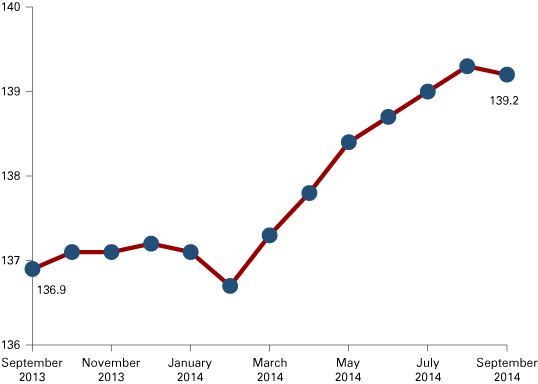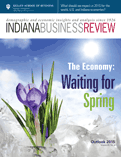Gary Forecast 2015
Assistant Professor of Economics, School of Business and Economics, Indiana University Northwest
In 2014, the northwest Indiana economy grew, but more slowly than both the state and national economies. Between September of 2013 and 2014, the northwest Indiana economy grew by 1.7 percent, as measured by the Northwest Indiana Coincident Index.1 Over the same time period, based on similar indices published by the Federal Reserve Bank of Philadelphia, the state of Indiana grew 4.6 percent and the national economy grew by 3.2 percent.2 Figure 1 shows the Northwest Indiana Coincident Index, which tracks the health of the northwest Indiana economy (Lake, Porter, Newton and Jasper counties).
Figure 1: Northwest Indiana Coincident Index

Source: Indiana University Northwest School of Business and Economics
The region’s slower growth was caused primarily by two factors: bad weather in early 2014 and the increasing replacement of high-paying manufacturing jobs with lower-paying service sector jobs. In addition, several major construction projects, which provided a short-term boost to the economy, were completed.
In January and February of 2014, a series of severe storms traveled across the United States and stalled economic growth nationwide. Northwest Indiana depends more heavily on the transportation, construction and recreation gaming industries than many other regions and was hit particularly hard. For example, on January 21, northwest Indiana received over 20 inches of snow, with the city of Gary getting 18 inches of snow in a five-hour period. Compared to the nation, employment in Lake County is 23 times more concentrated in the gambling industry, twice as concentrated in the trucking industry and 1.5 times more concentrated in the construction industry.3 Indiana casinos experienced their worst month in more than a decade, with a 17 percent decline in revenues during the month of January alone. In addition to severe weather affecting these industries heavily, it took longer for the region to recover than the state and nation.
The second major reason for limited economic growth in 2014 is an ongoing trend in employment. Since the 1970s, the urban core of northwest Indiana has been experiencing a decline in manufacturing and manufacturing-related employment, similar to other Rust Belt regions nationally. Since 1990, northwest Indiana has lost 15,000 jobs in primary metal manufacturing—a 46 percent decline.4 Even so, employment in Lake County remains 23 times more concentrated in primary metal manufacturing than the rest of the United States. As these jobs decline, they have typically been replaced by service industry jobs, often in retail and food service, which are generally lower paying and have fewer benefits.
While employment in health care has recently provided a bright spot and continues to expand, construction employment declined significantly in 2014. During 2013 and 2014, a major source of construction jobs in the region was the BP Whiting refinery project—a $4.2 billion upgrade, which employed more than 14,000 skilled tradesmen at its peak. The project was mostly completed by December 2013. Another major source of construction jobs was the Gary regional airport runway extension project, which was also completed at the end of 2013.
Table 1 shows the sectors of employment in northwest Indiana that experienced the largest gains and losses in 2014. While total employment increased slightly in 2014, the nature of the jobs changed significantly. The majority of jobs lost were in the goods-producing sector—specifically construction and, to a lesser extent, manufacturing. These job losses were offset by increases in employment in the service sector, both in leisure and hospitality (specifically food service and drinking places) and government (specifically local government).
Table 1: Northwest Indiana Sectors with the Largest Employment Gains and Losses
| Sector | Change in Employment (Sept. 2013 – Sept. 2014) |
|---|---|
| All Sectors (Total Nonfarm) | 400 |
| Goods-Producing | -3,100 |
| Construction | -2,800 |
| Manufacturing | -200 |
| Services-Providing | 3,500 |
| Leisure and Hospitality | 1,600 |
| Government | 1,100 |
Source: U.S. Bureau of Labor Statistics, Current Employment Statistics
While the region’s economic growth in 2014 was significantly less than that of Indiana and the nation, this was mainly due to several specific one-time events rather than any significant long-term economic shift in the region.
While the significant decline in construction employment would normally be a concern for the region, there are a number of upcoming projects that will likely offset this for the next few years. In 2014, some noteworthy new commercial retail construction projects were started, including the Shops on Main development in Schererville. While this development had a relatively minor effect on construction employment, many of these upscale retail shops (for example, northwest Indiana’s first Whole Foods) may very well represent a bellwether of expansion to come.
In 2015, Indiana University Northwest will begin construction on a $45 million Arts and Sciences academic building—one of the largest non-manufacturing construction projects in Gary in the last few decades. The Illiana Expressway, a controversial toll road extending from northeast Illinois to northwest Indiana is slowly moving ahead after being stalled for several years. The West Lake Corridor extension of the South Shore Commuter Line passed an important milestone in March 2014 and is moving ahead. The project, which is expected to cost between $570 million and $615 million, will provide a significant boost to the region, both directly in terms of construction jobs and indirectly in the future through improved commuter transportation and access to job opportunities in Chicago. However, construction is unlikely to begin until 2020.
What’s in Store for 2015?
The Northwest Indiana Coincident Index also provides a forecast for the growth of the economy and employment in the upcoming year. Table 2 shows forecasted growth in the economy and employment for 2015, along with forecasted and actual growth for 2014. Based on the index, the Northwest Indiana economy is forecasted to grow 2.2 percent in 2015 and regional employment is forecasted to increase by 0.7 percent or generate 2,000 new jobs.
Table 2: Northwest Indiana Regional Forecasts
| 2014 Forecast | 2014 Actual | 2015 Forecast | |
|---|---|---|---|
| Economy | 2.2% | 1.68% | 2.2% |
| Employment | 0.8%
(2,000 jobs) |
0.15% (400 jobs) |
0.7%
(2,000 jobs) |
Source: Authors calculations, using Northwest Indiana Coincident Index data
While any economic and job expansion is positive, growth at this rate would still leave the region approximately 11,000 jobs (or 4 percent) below the pre-financial-crisis employment high in 2007. The economic forecast for northwest Indiana in 2015 is positive. The region is likely to see positive economic growth in the next year; however, it is likely this growth will continue to be slower than both the state of Indiana and the nation overall.
Notes
- The Northwest Indiana Coincident Index is released monthly by the School of Business and Economics at Indiana University Northwest at http://go.iu.edu/nwi.
- See the State Coincident Indexes from the Federal Reserve Bank of Philadelphia at www.philadelphiafed.org/research-and-data/regional-economy/indexes/coincident/.
- This is based on the Bureau of Labor Statistics location quotient calculator at http://data.bls.gov/location_quotient.
- U.S. Bureau of Labor Statistics, Current Employment Statistics.




